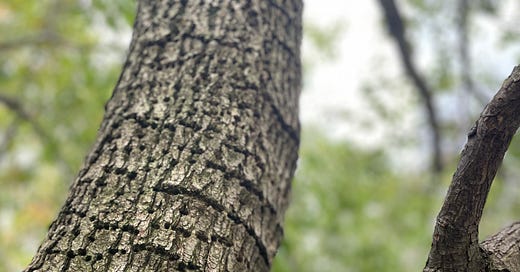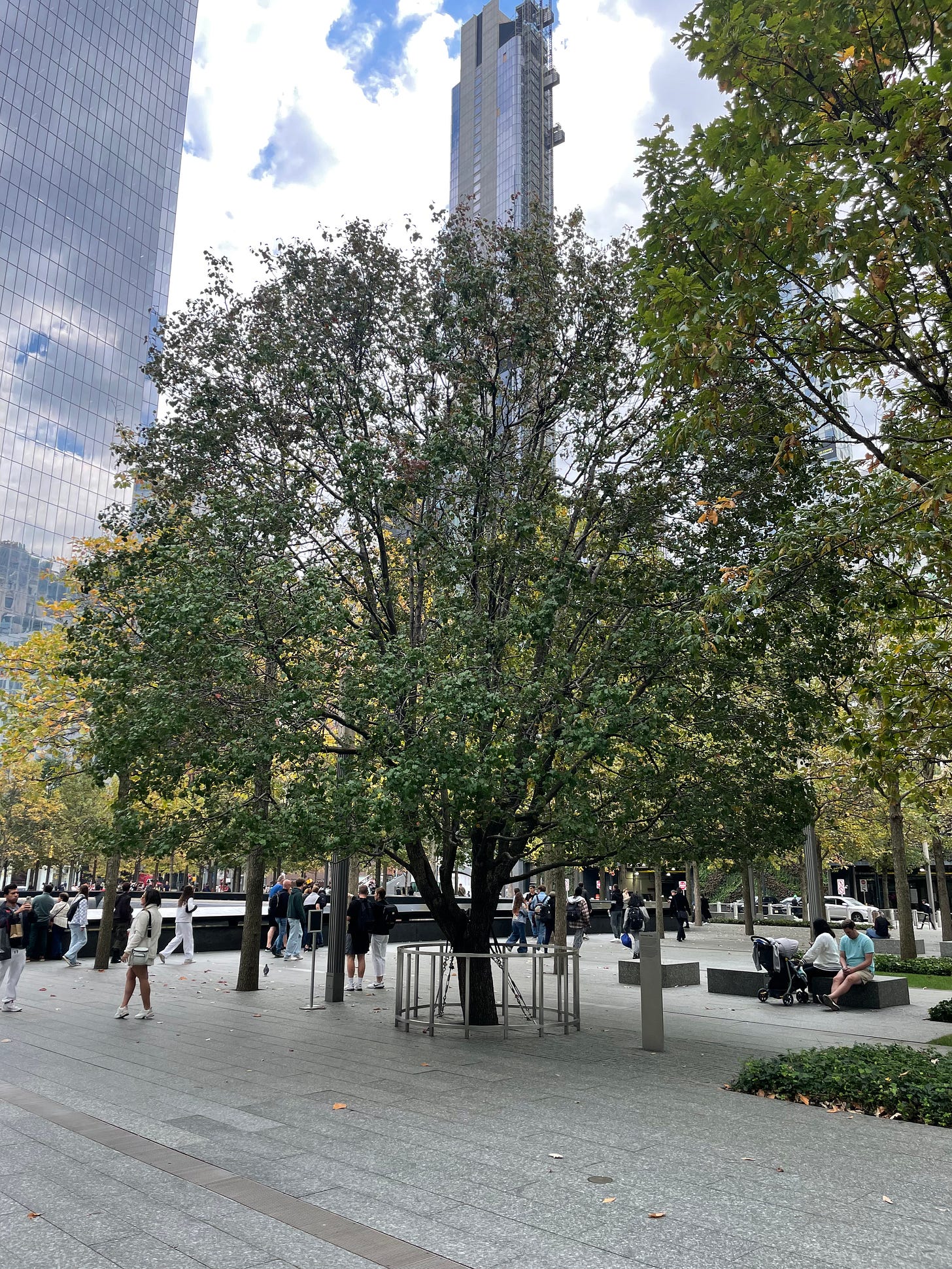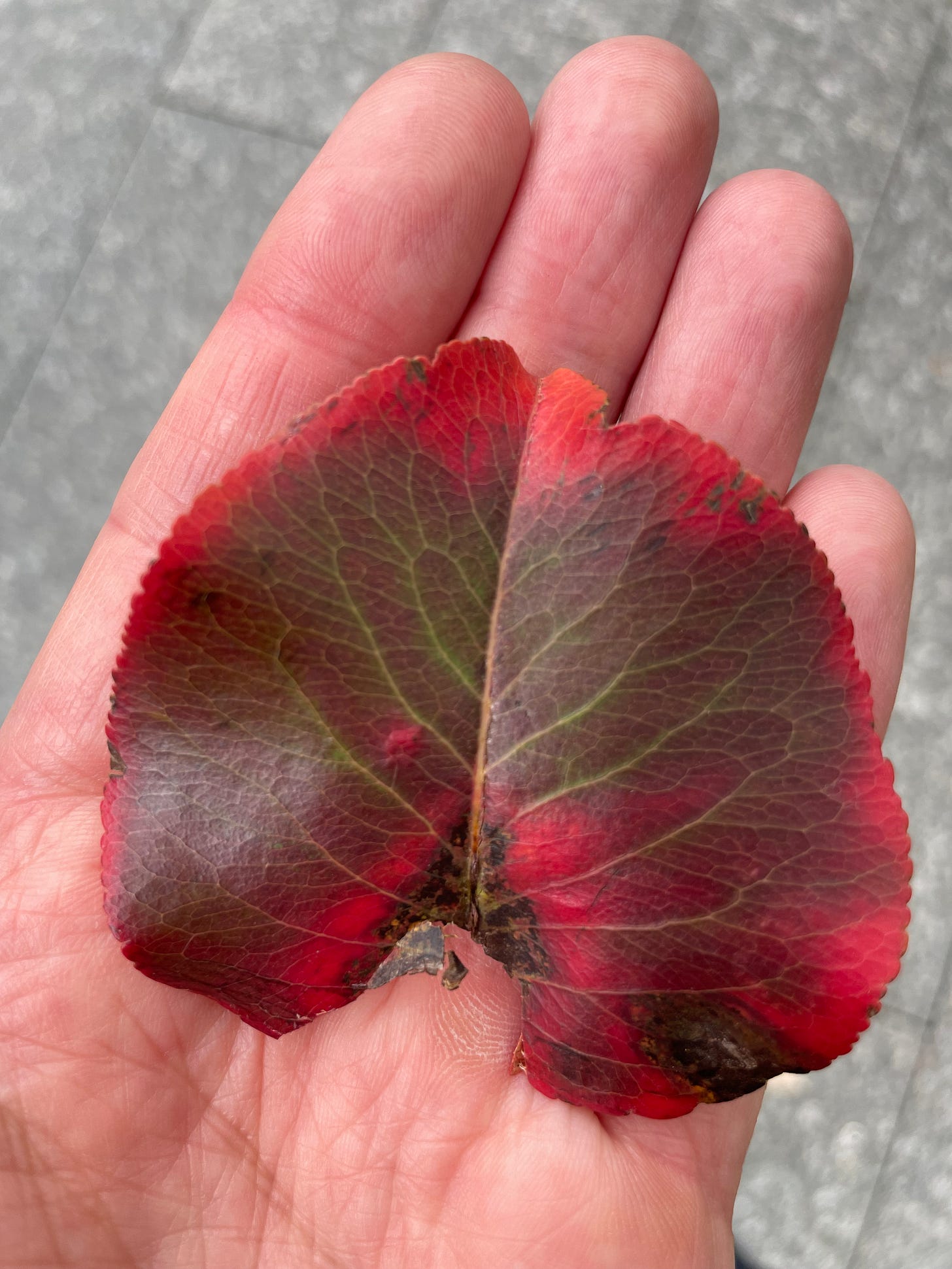I had thirty-six hours in New York City. Of my sixteen waking ones, twelve were already booked. That left me with four hours for trees, which translates roughly to one large-scale garden (including travel time) or two individual tree landmarks. My hotel was near Washington Square Park, which hosts the Hangman’s Elm and an assortment of preposterously well-maintained American Elms and Pin Oaks, so that was two hours that I’d have to set aside. I decided to reserve the remaining two for the 9/11 Survivor Tree, which, to my everlasting shame, I never saw when I lived in New York.
I got off at the WTC Cortlandt stop, where I followed the Wednesday afternoon crowd to the two open reflecting pools. They’re very beautiful with their pouring water and immensity, and I ran my hand over the austere names inscribed into bronze. I thought about how the bloodshed on that day scarred my life and everyone else’s, and how a hundred names could sit in between each of the ones I touched and still not account for all of the innocent people who helplessly paid with their lives for this hideous act in the following years. That memorial would be closer to complete.
People are inherently awkward at memorial sites. They have no idea what to do if they aren’t crying, so they often stare down the photographer in pictures in an effort to simplify the complex emotions that these things often bring up: sadness, shame, peace, anger, nostalgia, inexplicable joy—it’s frightening to think about all these things popping in at once so staring intensely seems the safest. I’m not sure what the dominant feeling was for me as I stared into the pools, but it certainly wasn’t peace. Regret, maybe.
I left the pools and strolled in between the 400 Swamp White Oaks (Quercus bicolor) which dot the grounds. It’s an interesting species that I don’t know a whole lot about, except that, like everything at the site, it’s super tough and meant to symbolize resilience because that obviously makes sense. It would be unadvisable to plant a bunch of Eastern Hemlock (Tsuga canadensis) around the memorial and watch as they slowly succumb to a scourge of woolly adelgids.
I was disappointed to learn that the original design of the grounds included an oval of Sweetgums (Liquidamber styraciflua)—known for their blazing, multi-colored fall foliage—but that these were ultimately removed from the design because they could distract from the focus on the pools themselves. I looked over to where the oval was supposed to have have been. It was October 18th, and the color would have been spectacular. But, instead, there were only Swamp White Oaks—dutifully spotted and yellowed. “Change” is a harder concept than “resilience” or “loss” at a place like this.
The first physical part of the Survivor Tree that I saw was its beautifully pruned crown, almost perfectly rounded and topping out around thirty feet. As a species, it’s close to anathema in the tree world: the Callery Pear (Pyrus calleryana) is the genetic forerunner of the unholy Bradford Pear, which is an invasive disaster and structural nightmare and probably needs no introduction to anyone reading this.
The Survivor Tree’s history is legendary in the tree world at this point: in October 2001, it’s broken, burned body was spotted poking above the wreckage and was then removed as the “last thing alive” from Ground Zero. It was a long shot to recover, but did, owing to the expertise and care administered by the city’s Parks and Recreation department at Van Cortlandt Park. It was replanted as part of the memorial in 2010.
Its trunk, ravaged by sapsuckers, has a definite weariness to it owing to its damage from the attack, but gives way to smoother branching that sprouted as the tree was recovering. This delineation was much more apparent years ago, and it must have been touching to see the new life borne of certain death in the first years of its new residency at Ground Zero. But the new bark now looks a lot like the old bark, the new branching shares the same sapsucker holes, and it’s difficult to parse the thing the tree was from the thing the tree has become.
I really wanted to find an emotional connection to this tree of such demonized species, which by accident became as holy a thing as we have from that day. I walked around it for about ten minutes, reading the plaque and taking stock of the anchored trunk and new buds. Touching it. I picked up the only leaf that had fallen. Green with a red border. New pigmentation in the form of anthocyanins created from residual sugars. Beautiful. Symbolically powerful. You know, like blood?
Thus far, the 9/11 memorial was tripping all the wrong propaganda wires in me. What I wanted were answers or catharsis or anything to counter ten days of children disappearing like ghosts from the face of the earth and watching words have less and less power to do anything about it. Instead I got bitter irony, indignant puzzlement, and poor metaphors. I shouldn’t have come down to this place.
I was very tired, and I sat down on a concrete bench just under the edge of the tree’s canopy. I watched the confused people taking selfies next to the reflecting pool. A couple with a crying newborn in a stroller came and sat down on the bench next to mine. I could tell they were first-time parents because of the way in which they were frantically shushing the baby and debating whether or not to give the pacifier like it was a shot of atropine. They popped it in. You did it, I thought. “You actually made the decision—and that’s the hardest part.” To accommodate these kind of parenting axioms, I sacrificed a large chunk of my temporal lobe responsible for tree identification which has made me a worse content creator but a more subdued father.
They started rocking the stroller back-and-forth.
The tourist groups arrived, captained by their authoritarian guides: “DO NOT TOUCH THE LEAVES” one shouted with a wagging finger, then, quietly, “he’s our Survivor Tree,” then, patting the trunk, again, “Survivor Tree.”
“She’s our Survivor Tree, and I love her,” a female tour guide said. I’ve sought out a term for many years that means “seeing oneself in nature”—something more solipsistic than “personification” or “anthropormorphosis” and more specific than “pathetic fallacy”—and I’ve never been satisfied, even amongst Japanese terms which are much more sophisticated than English ones about these things.
When any tour group—Chinese, Italian, Chicagoan—would turn to their next stop, there would inevitably be someone, usually a man, who would check that no one in his group was watching him then lightly brush the trunk with his hands like it was the last puff of a forbidden cigarette. So wildly immature, so enjoyable to watch.
The baby was now sorrowfully cooing its final protests, and the man was resting his head against the woman’s shoulder. He removed her hand from the stroller and took over rocking it.
A group of sixth-graders walked up with a no-bullshit teacher who said something like “I swear to God if I see one of you even sniff a leaf…” None of them did. The show-offs even stopped showing off for a second in order to put their hand along the bark that had smoldered a decade before their birth. “Whoa,” they said. Then, one twelve year-old after another, “Wow,” “whoa,” “whoa".” I was the guy with the new creepy smile at every expression of disbelief.
The selfies were also different next to the tree. Over by the reflection pool, they were strained and mannered. There, one’s mere presence placed them squarely in the fortunate end of the mortal binary: “Here simple dead. You simple living. Make faces accordingly. “
But near the tree the poses seemed genuine, like the tree granted permission to the selfie-takers to be happy in each other’s company or even goofy whilst acknowledging the compulsory reflection just a stone’s throw away at the reflecting pools. It’s always a little silly to try to be serious in front of a tree, no matter how important it is. Living memorials require additional maintenance and are prone to more varied kinds of disrepair, but they also, in my opinion, elicit a broader and deeper experience in their observers.
How nice it would have been to have those Sweetgums there in this moment—to know that solemnity can be a rainbow and that its builders knew so, too; to see the turning of the leaves and to know there was a place that invited you to match the involuntary careening of your soul from feeling to feeling, from loss to longing to shame to hope to anger to joy to silence.
The baby was quiet now, and the man seemed to be dozing off. The woman gently shook him awake, took hold of the stroller, and they wordlessly wheeled off. I have no idea if they knew which tree they were sitting under or if they cared. At the very least, they had much larger concerns.
Things were shifting in me. I wanted to tell everyone who was wondering if they should text me but didn’t last week that it wasn’t a big deal, because I also had just as little to offer them. And to the spaces in between the names in bronze. And to the new spaces that are widening with every passing day. All I have is cowardly silence because—and I beg your pardon—I still can’t stomach the thought of any life being forcibly taken from its owner. I’ve had trouble getting beyond that to anything approaching eloquence these past few weeks. I would apologize for this silence, but every time I try to put into words the things that I feel about mass death, the less I understand them.
But there was the tree above me, made holy not by its chance survival but by the belief of millions that it had meaning. And how perfect to sit there in that purity of feeling, giving in to the absurd sensation that not only are people good, but that they are so, so good. That they are jewels, each illuminated a different color on the Tree of Life. They they are limitless in their cooperative abilities, if only they are shown granular and beautiful visions of that harmony. How much I wanted to show them that vision!
I looked at the exasperated mothers shaking their heads at their whining children. I had no desire to engage in sarcasm, which I always do. I felt a world away. I hoped this was the real me. I hoped this was the real all of us.
But hope is the new chaos, and I’m told that it does no one any good to wallow in it.







This felt like reading a beautiful diary entry. I really find comfort in the wit and wisdom shared here. Thank you for writing it down and hitting publish.
Beautifully written. Sorry not to be in town while you were here